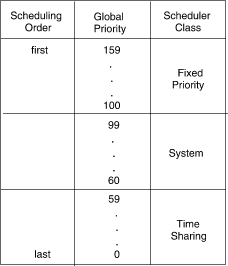
|
|
The following figure shows the scheduling order and global
priorities for each scheduler class.

Scheduler class order and priorities
When your system is built, it constructs this information from the tunable parameters and scheduler parameter tables described in the following sections. You should not have to change the default configuration.
Although you are not forced to configure scheduler classes to produce consecutive, nonoverlapping global priorities like the default priorities, we recommend that you do so for the sake of simplicity. Likewise, we recommend that you make all fixed priority global priorities greater than the global priorities of all other classes. These conventions simplify scheduler configuration, and they should accommodate any requirements on the scheduler.
Kernel processes such as the swapper and the paging daemon run in the system scheduler class. Kernel processes must compete with user processes for CPU time and, in the default configuration, all fixed priority processes have higher priorities than all system processes. Therefore, fixed priority applications must be written carefully to ensure that the kernel gets the processing time it needs. Also, if you reconfigure the scheduler, make sure that the system class gets enough priority over the time-sharing class to give kernel processes the CPU time they need.